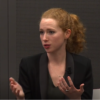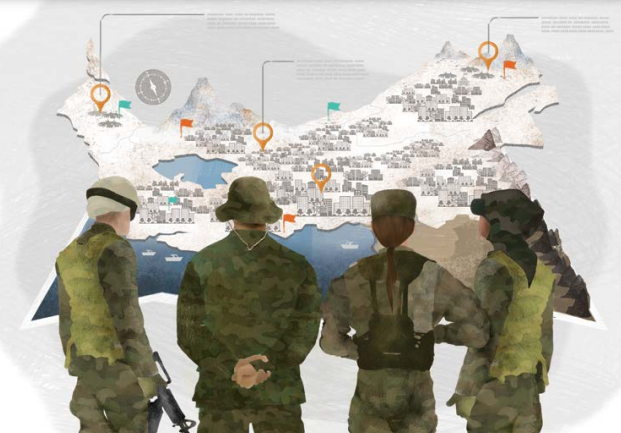Gender shapes an individual’s experience of armed conflict in complex ways, but trends can be predictable. In particular, women and girls contend with structural gender inequality, including in conflict contexts. Women and girls generally have fewer financial resources, less access to essential services and less representation in decision-making bodies. Military operations do not therefore take place on an ‘equal playing field’ for women and girls, and with this in mind, a gender perspective is a relevant tool for practitioners of international humanitarian law (IHL) as they seek to understand and reduce civilian harm.
In this post, Helen Durham, Cordula Droege, Lindsey Cameron and Vanessa Murphy launch the ICRC’s new report on Gendered Impacts of Armed Conflict and Implications for the Application of IHL. This kicks off a burst of posts co-hosted by the ICRC and Just Security as part of a series on Gender and Conflict. In the coming months, the series will feature contributions from a range of experts exploring the humanitarian, legal, and military implications of – and challenges raised by – the integration of a gender perspective into the interpretation and application of IHL.
Despite the guarantee of equal rights for women and men in international law, women and girls contend with gender inequality in every country worldwide. Reports indicate that in humanitarian settings, the situation is particularly grim. Over 21 per cent of primary school-age girls are out of school compared to 15 per cent of boys. The percentage of households headed by women typically reaches 33 per cent of the total, and these households face higher risks of malnutrition and food insecurity. Less than 20 per cent of women are likely to be in paid work in countries experiencing protracted conflicts, compared to 69 per cent of men. The actions of warring parties cause further harm with gendered dimensions, and – as if war was not enough – the COVID-19 pandemic has widened the gender gap in recent years.
On the current trajectory, it is estimated that it will take 135.6 years to close the gender gap worldwide. In other words, military operations take place on gendered terrain. In this post, we unpack some implications of this for IHL practitioners, distilling a selection of key issues from the ICRC’s new report on Gendered Impacts of Armed Conflict and Implications for the Application of IHL. The post begins with five facts to guide practitioners seeking to understand gendered impacts of armed conflict. It then illustrates how a gender perspective can and should be applied to IHL obligations, using the example of the principle of precautions. Finally, it identifies ways forward towards the better alleviation of the gendered harm wrought by armed conflict, including by amplifying existing good practice and leveraging the vector of the United Nations (UN) women, peace and security agenda.
Standing on shoulders: a note on provenance
The report and this post reflect discussions at an expert meeting that the ICRC convened in 2021. At the meeting, the ICRC sought to engage academics and practitioners in a critical reflection on the role of IHL in addressing the gendered impacts of armed conflict. One of the key findings from the discussion was that incorporating a gender perspective into the application of IHL is a building block for progress towards the alleviation of gendered harm wrought by armed conflict.
This entails mainstreaming a gender perspective across the ICRC’s legal work, an approach underway in the ICRC’s project to update the Commentaries on the Geneva Conventions (see here and here). It also echoes the rationale of the 1995 Beijing Platform for Action (para. 141), wherein 186 States agreed that the mainstreaming of a gender perspective should be promoted in decisions addressing armed conflict.
Almost 30 years on, the implications of gendered impacts of armed conflict remain relatively poorly understood among decision-makers and planners applying IHL. This post aims to provide some starting points and orientations for future progress.
Five facts about understanding the gendered impacts of armed conflict
1. Civilian harm is comprised of different impacts for diverse women, men, girls and boys.
Gender shapes an individual’s experience of armed conflict in complex ways. Structural gender inequalities pre-exist armed conflict, gender roles and social power dynamics can shift and/or be exacerbated in the course of armed conflict, and gender intersects with other identity factors including age, class, disability, race, religion and sexual orientation to determine individual experiences.
With this variation in mind, the kind of gendered harms that people may experience as a result of the conduct of hostilities can arise from differences in biological sex as well as differences related to their socially ascribed roles and responsibilities. For example, sex-specific harms arise from the use of certain weapons, and gender analysis of civilian casualty data indicates that women, men, boys and girls are killed at different rates depending on the context and weapon used. Such harm can be both direct and indirect. Gendered direct effects can include, for example, loss of life and injury to women and girls resulting from an attack in a context where they had unequal access to medical care. Gendered indirect effects can include, for example, the increased caretaking and income-generating responsibilities for women when male relatives are killed or injured.
2. Gender inequality is present in theatres of combat.
Gender inequality worldwide, including in countries affected by conflict, is well-documented and therefore foreseeable. Such inequalities are likely to exacerbate the direct and indirect civilian harm caused by hostilities: women are likely to have fewer financial resources to cope with injury and property damage, are more likely to be discriminated against because of disability, may face additional barriers to accessing health care when injured (for example, when they can only be examined by female health-care workers or need male guardianship to travel), and are likely to be less represented in decision-making roles regarding humanitarian aid delivery.
3. Gendered impacts are felt by everyone (not ‘just’ women and girls).
Though the inequality impacting the experience of women and girls merits dedicated analysis, gendered assumptions and expectations shape the experience of all persons, including men and boys in the conduct of hostilities. In certain situations, men and boys may be presumed to be combatants or to pose security risks by simple virtue of their gender. This can lead to problematic results, such as gender and age-based targeting of men and their exclusion from incidental harm estimates. Such examples underline the fact that gender affects the conflict-related experiences of women, men, boys and girls differently, but that it certainly affects all.
4. Gendered data gaps make women and girls more ‘invisible’.
The historical ‘invisibility’ of women to data capture is becoming more deeply understood, and data gaps are increasingly mapped. Data collection methods that do not account for stereotypes, social norms and other factors can introduce bias that compromise data quality, with knock-on blind spots in decision-making.
However, a lack of specific data on civilians in a theatre of operations does not preclude generalized guidance from commanders based on evidence-based trends and patterns regarding the inequalities and risks facing women and girls in conflict-affected contexts. One such measure that could help parties to better understand the impact of attacks is the monitoring, tracking and reporting of sex- and age-disaggregated civilian casualty data, and the use of these findings to inform future assessments of reasonably foreseeable harm.
5. Who is applying the law can affect how it is applied.
For example, the notion within IHL of the ‘reasonable military commander’ might be vulnerable to gender biases; the standard of ‘reasonableness’ in practice can vary depending on the identity of the military commander and their value judgements.[1] Based on gendered assumptions, a military commander might ascribe different value to different types of civilian harm. They might also be more likely, or less likely, to consider certain types of harm as ‘reasonably foreseeable’. In some cases, this may be influenced by a decision-maker’s own gender, and it is relevant in this respect that militaries comprise a majority of men. Research in other fields has demonstrated that the inclusion of women tends to broaden the scope of information brought to the table. Training for armed force personnel with decision-making responsibilities should thus consider whether gender bias is an issue in how they are applying IHL, and how this would best be addressed.
Implications for the application of IHL: example of the principle of precautions
These understandings of gendered civilian terrain can inform how practitioners apply IHL obligations. Take the obligation of precautions in attack: IHL requires that all feasible precautions must be taken to avoid or at least minimize incidental civilian harm (Art. 57(2) of AP I, Rule 15 of the ICRC Customary IHL Study). The ability to take precautions to minimize injury to civilians relies on the military practitioner’s understanding of the kind of harm that might result from an attack. Practices such as assessing patterns of civilian life – which vary across age, gender and culture – can help inform these assessments. A gender analysis of such patterns of life could help commanders understand how different groups use the space, and correspondingly how they will be differentially affected by an attack.
For example, such a gender analysis may have implications for warnings in attack. IHL requires that, unless circumstances do not permit, effective advance warning must be given of attacks that may affect the civilian population. The effectiveness of a warning should be assessed from the perspective of the civilian population that may be affected, including women and girls. It should reach and be understood by as many civilians as possible among those who may be affected by the attack, and it should give them time to leave, find shelter or take other measures to protect themselves.
In this respect, lower literacy rates and lower access to digital technology among women and girls underscores that, in certain contexts, women and girls may be disadvantaged if warnings are issued only through written information and/or digital means. In such contexts, this kind of warning is likely to be less effective for many women and girls. Implementing effective warnings might therefore require the presentation of accessible information in a variety of formats that would, taken together, help overcome the limited access women and girls have to digital communication and comparatively lower literacy rates: for example, through the use of a combination of radio messages and leaflets with image-based (instead of solely written text) warnings. Another issue may be that, in a given context, women and girls spend considerably less time than men and boys outside the home. In such a context, effective warnings that reach persons at home could include media broadcasts and phone calls.
The obligation of constant care is also particularly germane to the discussion on mitigating gendered civilian harm. This general obligation supplements the basic rule of distinction and requires that, in the conduct of military operations, constant care shall be taken to spare the civilian population, individual civilians and civilian objects (Art. 57(1) of AP I). It is an obligation of conduct, to mitigate risk and prevent harm, and applies in the planning or execution of any military operation.
The application of a gender lens to the collection of information during such operational planning could include: whether troop location, including at check-points and through patrols, exposes different women, men, boys and girls to new risks; whether certain medical services are more accessible or important to women than others (e.g. some may not have women staff, availability of gynaecology and obstetrics services);[2] whether women have less access to vehicles in situations where civilians are expected to flee (for example, if many women in a context cannot drive), whether women and girls have lower literacy rates or access to digital technology, and whether implications arise from the fact that women and girls are likely to have more care responsibilities for children, the sick or older persons in situations where civilians are expected to flee.
Where to? Good practice and opportunities in the women, peace and security agenda
While gender remains a fringe and fraught issue for many militaries, progress is being made. There are pockets of good practice on the integration of gender perspectives into military operations. Examples include the incorporation of gender advisers in positions of influence and gender coaching for military leaders. Guidance for militaries from DCAF and the Nordic Centre for Gender in Military Operations are instructive resources.
More granularly, if IHL obligations governing the protection of civilians are to be translated into practice in a manner that takes account of gendered impacts, then knowledge, skills and tools are required. Pragmatism is key. For example, a good starting point towards incremental progress could be a simple, practical tool such as a checklist that sets out the kinds of questions that personnel should ask when assessing civilian harm. Including questions such as ‘how do women, men, girls and boys of different ages and abilities use, need or rely on this place or space differently?’ and ‘how does the value of the civilian object differ for women, men, boys and girls?’ in existing guidance would help mainstream gender perspectives into analyses and decision-making.
It is fitting to conclude by placing this discussion in the context of the UN’s women, peace and security (WPS) agenda. The policies and practices discussed above could be spurred by the vector of WPS, as a key site of progress in international policymaking regarding women and girls in armed conflict. The place of IHL therein – already firmly embedded within WPS resolutions – could be further leveraged. As part of its ‘protection’ pillar, WPS-related Security Council resolutions call on states to apply obligations of IHL to protect women and girls in armed conflict. The ICRC submits that this pillar of protection would be enhanced if States incorporated a gender perspective in the application of IHL obligations. For example, WPS National Action Plans or related policies could commit to striving to apply and interpret IHL using a gender perspective, with the aim of ensuring that the protection of women and girls in armed conflict is maximized and inequalities are taken into account.[3]
[1] For example, the diverse views of expert witnesses during the Gotovina trial at ICTY illustrate the differing assessments that military commanders might have. For a summary and analysis of the experts’ testimony covering the principles governing the conduct of hostilities, see: M. Brehm, Unacceptable Risk: Use of explosive weapons in populated areas through the lens of three cases before the ICTY, PAX, 2014, p. 60.
[2] Relatedly, the United Kingdom MOD states in its operational policy on human security that access to health care must take into account gender-specific services; see: United Kingdom MOD, Joint Service Publication 985: Human Security in Defence, MOD, London, December 2021, p. 5.
[3] The Swedish National Action Plan makes this commitment; see: Government Offices of Sweden, Women, Peace & Security: Sweden’s National Action Plan for the implementation of the UN Security Council’s Resolution on Women, Peace and Security 2016–2020, Government Offices of Sweden, Stockholm, p. 13.
See also
- Drew Ambrose, Reporting sexual violence in a conflict zone, December 9, 2021
- Daniel Palmieri, Sexual violence in armed conflict: the historical limits of humanitarian action and the ICRC in the 20th Century, December 2, 2021
- Christie Edwards, Gender-based hate crime as an early warning indicator of escalating violence and armed conflict, November 30, 2021
- Rachael Kitching, Vanessa Murphy & Kelisiana Thynne, Walking the talk on SGBV: an implementation checklist to narrow the gaps between international law and domestic practice, November 25, 2021









Comments